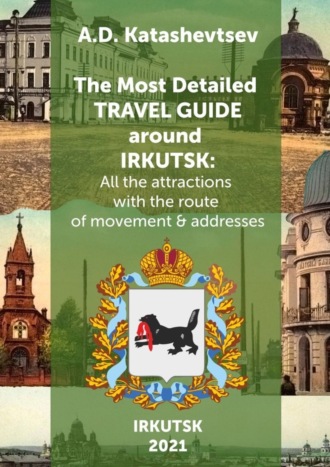
Полная версия
The Most Detailed Travel Guide around Irkutsk. All the attractions with the route of movement & addresses

The Most Detailed Travel Guide around Irkutsk
All the attractions with the route of movement & addresses
Alexander Dmitrievich Katashevtsev
© Alexander Dmitrievich Katashevtsev, 2022
ISBN 978-5-0059-0174-3
Created with Ridero smart publishing system
Introductory Words
Dear guests and residents of the Baikal region, here is the most detailed guide to the capital of Eastern Siberia. This includes the brightest and most unusual sights that will help you get acquainted with the most interesting moments from the past, present and future of Irkutsk. Almost 75 kilometers of routes along more than 90 streets of the city.

Routes of travel guide
This book is my appreciation and gratitude to my historical homeland, as well as the result of ten years of work as a guide on various thematic excursions. Thirteen generations of my family live on Irkutsk land. Twice my ancestors in the 19th century became the mayors of Irkutsk. With my work, I hope I will be able to thank my hometown for everything that it has done and created for my family. I would like to believe that this book will help you fall in love with Irkutsk the way I do.
Irkutsk Railway Station
We begin our journey from the building of one of the most beautiful railway stations in Russia, built in 1907 by the architect V.I. Kolyanovsky. The rails of the Trans-Siberian Railway came to Irkutsk in 1898, and this was a great event, not only because it connected the city with the central part of the country, from which the city was separated by thousands of kilometres of poorly developed territories, but also as it led to a doubling of the population and the opening completely new perspectives.
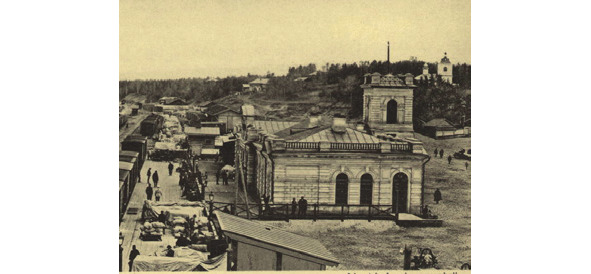
The first railroad station of Irkutsk
But it could be left out from the “great steel road”, like Tomsk, Kolyvan or Nerchinsk, but the mighty mountains of Lake Baikal did not allow this to happen. After six geotechnical expeditions (from 1887 to 1902), it was decided to build the Trans-Siberian exactly through Irkutsk, despite the recommendations of Emperor Alexander III to avoid the capital of Eastern Siberia.
It is no coincidence that we begin our journey from here, since the Irkutsk railway station is located right at the foot of Kayskaya mountain, which glorified the city throughout the world with the discovery of the Glazkov necropolis – the largest ancient burial ground in the territory of the modern city.

Arrival of the first train to Irkutsk
On the whole territory of Eastern, Western Siberia and the Far East taken together were founded as many stone age graves as at the area of the Lokomotiv stadium, which is located nearby the railway. Moreover, this amount is only 2% of the total number of finds, many of which are the high valuable artefacts that adorn more than one collection of museums in Siberia and central Russia.
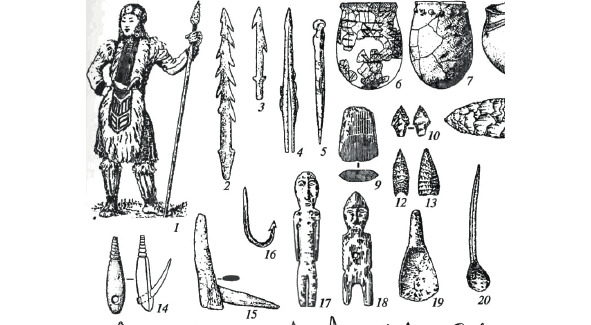
Glazkov culture
We will continue our movement along Chelnakov street, named after military twice hero of the Soviet Union, General N.V. Chelnokov, who flew more than 270 sorties, killing the enemies in the air and on the ground from Baltic to Black Sea. How symbolic that he was born in Irkutsk on May 9, 1906 which is a day of great victory in WWII. The monument to him was established at the entrance group to the Sverdlovsky district of the city unforgivably late: only on October 2, 2016, to the 110th anniversary of the birth of aviation general.

Twice hero of the Soviet Union, General N.V. Chelnokov
Glazkovsky Bridge
Directly from a small park near the monument, we go to Glazkovsky Bridge – the oldest bridge in Irkutsk over the roaring daughter of Baikal called the Angara River. And although it had a predecessor – the pontoon Nikolayevsky bridge, the remains of which are still visible at the bank downstream (existed since 1891) – a permanent ferry began operating in Irkutsk only in 1936. By the time of completion, it was the most long-span concrete bridge in the USSR.
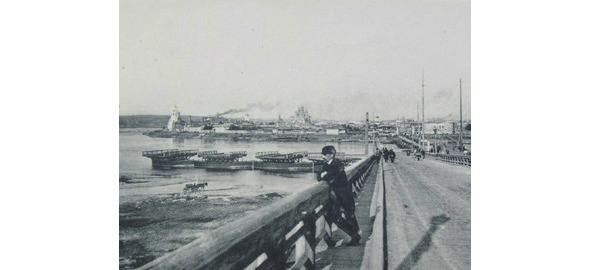
Pontoon bridge
The architect of the bridge was the author of the mausoleum to V. I. Lenin and the tribune on Red Square in Moscow I.A. Frantsuz. And on the penultimate parapet stand on the left, you can still see a sign that this bridge is a monument to V. I. Lenin.

Glazkovsky bridge in 1936
And now we will find ourselves in the center of Irkutsk, where immediately on the right we are greeted by the beautiful Holy Trinity Church, built in the style of the mysterious “Siberian Baroque”. It was consecrated on September 22, 1778 and, despite the fact that it suffered from many floods and fires, it is the only one in the city that has possessed the ancient roofing iron forged in smithy.

Holy Trinity Church
Until the middle of the 19th century, this temple was the only place of prayer for residents of Glazkovsky suburb on the other side of the Angara River, where the Troitsky ferry was arranged. The only planetarium in Siberia was opened in an abandoned church building since 1950, which worked until 1983.

Planetarium in Trinity Church
Behind the powerful silhouette of the temple you can see the only church-rotunda in Irkutsk. It was consecrated in the name of St. Gregory of Neocaesarea in 1805 and built according to the project of the famous architect A.I. Losev.
We pass along Chekalov Street and at the entrance to the embankment we are greeted by a monument to veteran of paratroopers, opened in 2018. Then we will turn right and dive under the bridge, where after on the right we will see one of the memorable buildings of Irkutsk – this is the former progymnasium of M.V. Hajduk. Today here is a center and a service for the preservation of the historical and cultural heritage of the Irkutsk region, as well as the Cosmonauts Square which is located nearby.
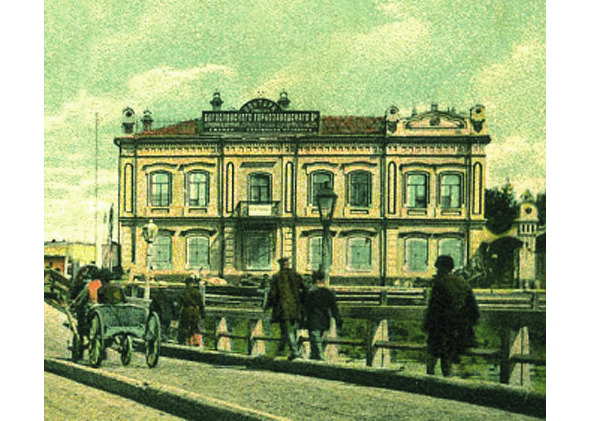
Progymnasium of M.V. Hajduk
The building located very picturesquely at the bend of the river. Exactly here was the entrance to the pontoon bridge and to the city once rested against the bank, and one of the floats is still visible in the water. In the troubled days of the Russian Civil War in December 1917 and 1919. here took place some of the bloodiest battles in the history of Irkutsk, and on March 7, 1920, next to this place on the ice of the Angara River, an ice triumphal arch was installed in honour of the soldiers of the 5th Red Army who were entering the city in victorious formation.
On the right we pass a waste-ground, where the complex of the most famous public baths in the city opened in 1896 by the famous Irkutsk homeowners N.P. Kurbatov and G.I. Rusanov and became the first such establishment where electricity was installed. For a long time Kurbatov Baths were one of the main resting places for Irkutsk residents.

Kurbatov’s Baths
On the next intersection on the right a monumental buildings attract attention – all this once belonged to the first yeast plant in a history of Siberia, the owner of which since 1882 was a J.M. Pertsel.
CESovskaya Embankment
CESovskaya embankment street, named after the oldest city power plant that operated in this area of the city for almost a century since 1910. It ends next to unusual building in the Stalinist Empire style with a hemispherical end on the northern facade. Here once was the one of the most outstanding temples in Irkutsk – Church of Sts. Procopius and John of Ustyug. It had characteristic stylistic features that later became dominant in the cult architecture of the city and determined the identity of the local school. Had been built in 1767, it was destroyed in the 1930s.

Miracle-Workers Church
In the last years of the church existence, since 1932, a direction of tea-packing factory which produced a half of all tea in the USSR was placed here. Today nothing reminds of the temple or plant, as well as of the building of the oldest power station in Irkutsk. The building of the factory which was the only enterprise in the country that produced tea during the WWII, was demolished, and one of the city banks is located in the former warehouse building. Also it is planned to construct one of the new architectural landmarks of Irkutsk on the site of the old power plant.
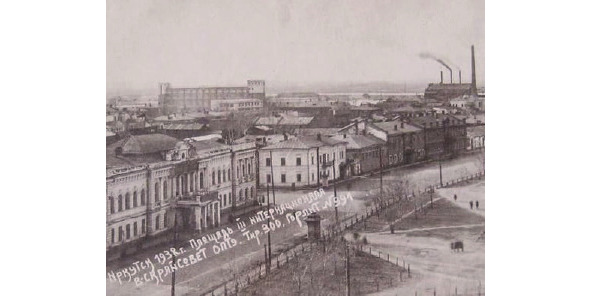
Tea-packing factory and CES
We move on and passing by “Lovers’ Square”, which is comfortably located right opposite one of the most beautiful wooden mansions in the city – this is the estate of the merchant and deputy of the Irkutsk City Duma I. I. Ogladin.

House of I. I. Ogladin
Immediately after it there is an interesting stone building, where from March 13, 1807 and until April 19, 1868 was the main Siberian office of the Russian-American Company, as evidenced by the memorable plate on the wall. Irkutsk, due to its favorable location, was once the center of Russian America or the American district of the Irkutsk Goberny with the center in Novo-Arkhangelsk on Alaska (nowdays Sitka, USA).
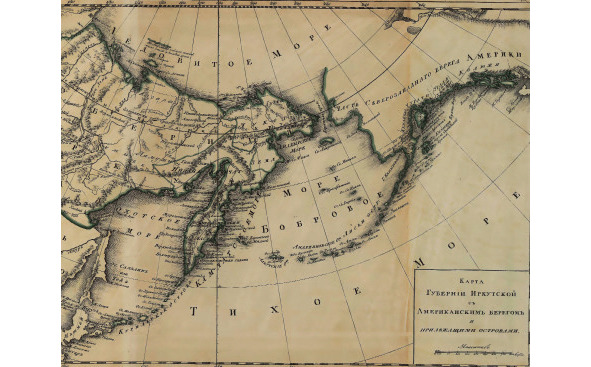
Map of Russian America
And now the “snow-white frigate” appears ahead – the beautiful Savior Church, which marks the exact place where the city of Irkutsk was founded. Let’s take a closer look at it, because this is the only building that has survived since the time of the wooden fortress, which was established on this place on July 16, 1661. Today from this date we count the official date of the foundation of Irkutsk, despite the fact that the city was founded on the site of an aboriginal settlements earlier (in 1620 and 1652). In the past, at the mouth of Irkut River, which flows here into the Angara, there was already a Russian winter hut for collecting “yasak” (tax with the furs of wild animals).

Irkutsk fortress in 1692
Church in the Name of the Savior
Let’s get meet the Church in the name of the Savior Image Not Made by Hands (Mandylion). Here once was kept that religious banner, which as a standards was brought to Siberia by Cossacks-pioneers. The temple was created by the Moscow architect M.I. Dolgikh, who not only built the building in the canons of the old Russian style, but also gave it a special local flavor.

Church of the Savior
Initially, the church was built right into the wall of a wooden fortress and on the first floor there was a warehouse for the state treasury, so people entered the temple which was located on the second tier through a wooden promenade-gallery. There is still reminiscent of that with the triangular ornaments between the first and second floors, where the balks were inserted, and on the second tier there are doors which leading to nowhere. On the south side of the temple on the second floor, you can still see in the window bars the date when the church got a bell tower (“1760”) so that was a time when the temple acquired a modern face.
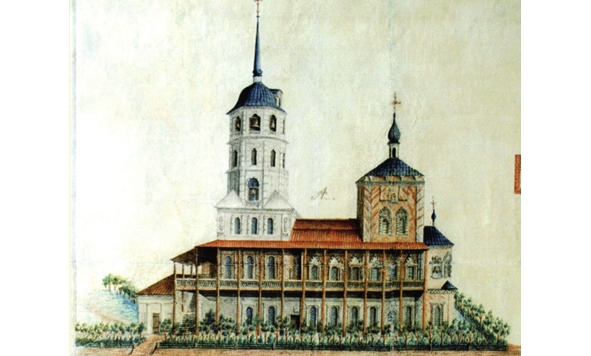
Promenade of the Savior Church
Moreover, in 1824 the Church of the Savior was painted by an artel of Moscow icon painters and until the end of the 20th century it remained the only painted church in entire Siberia. It was not customary to paint temples in the local climate because of the sudden changes in temperature that ruined any paint. The frescoes amazingly preserved thanks to the fact that in Soviet times they were covered with four layers of plaster and under this protective cap they spent almost half a century.
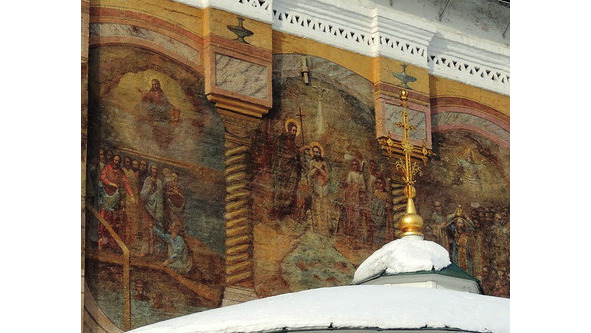
Frescoes on the church
In the murals, from left to right you can see scenes of christening the local Buryat population, the image of Epiphany, as well as the rite of passage of the first bishop of Irkutsk and Nerchinsk known as St. Innocent Kulchitsky. In addition, on the southern wall of that temple you can also see the icon of the Savior Not Made by Hands, images of St. Nicholas and St. Mitrofan of Voronezh.
Surprisingly, Orthodox churches adjoin a monument to the “flaming Gothic” a operating Catholic church in the name of the Assumption of the Blessed Virgin, which was built on this site in 1883 by the project of I.J. Tamulevich mainly for the descendants of exiled Poles at least 20 thousand of which passed through Irkutsk during 19th century. The names of many of them today are in the denotation of streets, mountain ranges and various types of plants and animals (Dybowski, Cherski, Chekanovski, Godlevski and many others).

Polish Catholic church
The temple was consecrated personally by the “Apostle of Siberia” Christopher Szwernicki, who was the first parish priest of the diocese of St. Joseph – largest geographical Catholic bishopric in the world (area of about 10 million km2), the center of which is still here in Irkutsk.

Christopher Szwernicki
In addition, according to legend, after the fence of that temple was buried P.P. Duntsov-Vygodovski – the last one of first Russian revolutionaries (Decembrists) who left in Siberia (died in 1881). And in 1951 here held the first industrial practice the world famous film director L.I. Gaidai at the East Siberian newsreel film studio.

P.P. Duntsov-Vygodovski
Inside the church today there is a real organ (27 registers and 1849 pipes), which was one of the four best in the USSR (along with the organs of Pitsunda, Riga and Kaliningrad). It was produced at the expense of the Irkutsk people by the famous German company “Wolfgang Schukke – Ortel Gebau”, made according to the drawings of J.S. Bach in Potsdam and installed in Irkutsk in 1978. Today, organ music concerts are held here weekly.

Organ hall in the church
Nearby to the Savior Church, where weddings are often held today, since 2011, there is a monument to the Holy Princes Peter and Phevronia of Murom – the patrons of family, love and marriage in the Russian Orthodox Church. A similar monuments can be seen in dozens of other cities in Russia, and the closest one is located in Angarsk, but in the capital of Eastern Siberia it is extremely popular. Newlyweds come here to ask for happiness in family life and first-borns; children – about brothers and sisters; old people – about grandchildren. It is believed that if you would rub the nose of bunny sitting next to Phevronia’s feet, then the wish will certainly come true.

Saints Peter and Phevronia
Memorial of the Eternal Flame
Walking around the site of the city’s foundation, we cannot pass by the Eternal Flame Memorial, which is rightfully considered one of the largest in Siberia. It’s appeared in Irkutsk quite early – to the 30th anniversary of the Great Victory in 1975, and two days later the students of the 39th school were at the Post at the Eternal Flame. The guard of honour is still carried out by ordinary pupils, and this tradition has never been interrupted for almost half a century. Perhaps that’s why in 2007 Post Number 1 in Irkutsk was awarded the 1st degree Medal of St. Alexander Nevsky.
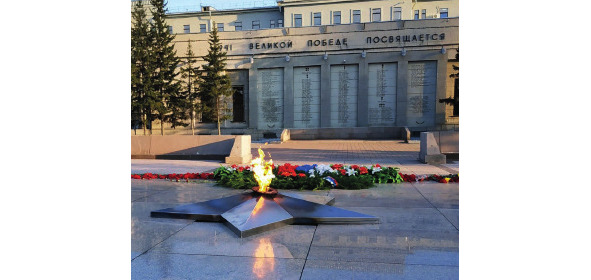
Memorial of the Eternal Flame and the plates with the names of Heroes
Around the Eternal Flame there are plates made of Baikal marble on which you can see the names of countries not only in Europe, but also in Asia – from France to Korea out of where the land was brought here stained with the blood of Siberian soldiers. Behind the memorial there is an annexe to the building of the government of Irkutsk region, where you can read the names of 134 Heroes of the Soviet Union participants in the Great Patriotic War associated with the capital of Eastern Siberia, as well as plates with lines from the Irkutsk poet and writer M.D. Sergeyev, telling about the contribution of the region to the victory.

214 thousand natives of the Irkutsk region went to war and every third did not return home (79 thousand), five pilots from Irkutsk made an air ram, three daredevils covered an enemy machine gun with their bodies. 22 large enterprises, about 10 trusts and raw material bases were evacuated to the Irkutsk region. There were 29 hospitals on the territory of Irkutsk, where more than 102 thousand soldiers were treated, less than a thousand of which were unable to survive from their wounds. The Irkutsk people sent 160 wagons of parcels and warm clothes to the front (a train more than 2 km long), raised funds for the construction of 6 tank columns, and contributed more than 1.2 billion rubles to help the front.
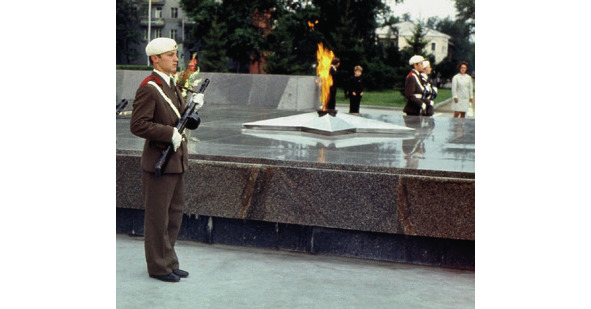
Post number 1 at the Memorial
The building of the Irkutsk Region government rises above the memorial complex. From here it’s controlled the fifth biggest region of Russia (area of 774,846 km2) with a population of less than 2.5 million people. The building itself was completed in 1959 by the architect K.I. Guryev, but its construction lasted for 20 long years, because its creation was only a reason for the destruction of the symbol of prosperity of Irkutsk at the end of the 19th century – the Kazan Cathedral.

Irkutsk Oblast Administration
This temple was the fourth largest religious building in Russia. It accommodated five thousand parishioners, and its height reached 61 meters. The construction of the temple took a long time (1875—1894) and cost to Irkutsk people almost a million golden rubles. The best architects of the region took part in the creation of the building project as V.A. Kudelsky and H.V. Rosen.
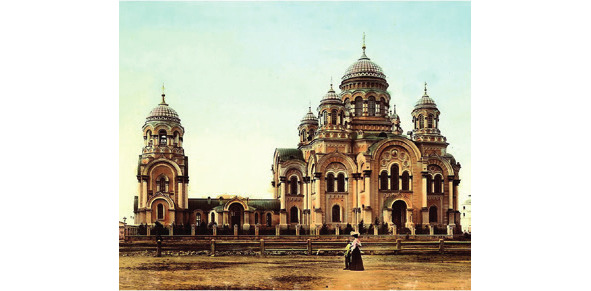
Kazan Cathedral
In August 1932, the cathedral was thoughtlessly blown up together with living people inside, who tried to defend the symbol of the wealth of their city. After the residents of Irkutsk refused to participate in the clearing of the debris, and a train with collective farmers was sent from Ukraine, who began to dismantle the church bumping into corpses. There were so many bricks that, despite the fact that it was used for the construction of the first five-story building in Irkutsk, the State Bank building and the access roads of the Glazkovsky bridge. The level of the surrounding area arose by almost a meter, when the broken material was flattened. That’s why the townspeople for a long time called this place as “Red Square”. On the site of the cathedral, nothing was ever built, because the walls of the governorate administration are more than 4 meters from the nearest walls of the destroyed church.
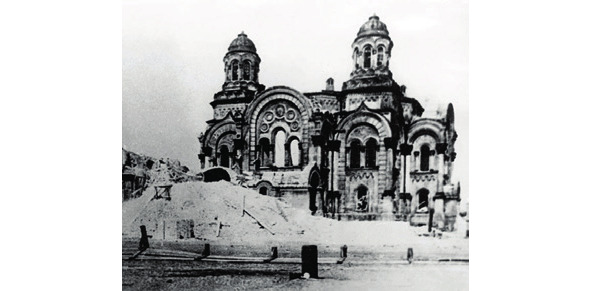
The destruction of the cathedral
From here we will walk along the veterans’ alley, because this whole park was created in its modern form in a memory of the 50th anniversary of the Great Victory in 1995. But this does not mean that before that it was empty. Since 1824, the Spassky Garden was laid out here, which was and still in use as a favourite place for festive fireworks.
Here we will see a monument to one of the three twice Heroes of the Soviet Union associated with the city of Irkutsk. Bust to the famous general A.P. Beloborodov in Irkutsk appeared back in 1954 on Labour Square and was moved here to the 50th anniversary of the Great Victory. It was his 78th Infantry Division that met the Nazis near Istra in the battle for Moscow in the winter of 1941 and stopped Hitler‘s Army first time ever and saved the freedom of Russia in an unequal battle. He received his first “Gold Star” for the liberation of Vitebsk on June 26, 1944, and the second for the fact that his soldiers were the first to break into the territory of the impregnable fortress of Koenigsberg on April 9, 1945. A.P. Beloborodov was buried in Moscow at the “Snegiri” cemetery, next to the soldiers of his division who died in the fall of 1941 during the defence of Moscow, but part of his ashe is under the memorial plate at the Irkutsk memorial of the Eternal Flame.

Twice Heroes of the Soviet Union general A.P. Beloborodov
The third twice Hero of the Soviet Union does not yet have a monument in Irkutsk, because this is the last living member of the first cosmonaut corps of the USSR – B.V. Volynov, who made the first docking ever between ships in open space on January 15, 1969. Two more Irkutsk residents visited the Earth’s orbit: A.A. Ivanishin and D.Y. Kondratyev. Considering the presence in Irkutsk of the Institute of Solar-Terrestrial Physics and the Institute of System Dynamics and Control Theory of the SB RAS, as well as plants for the production of space equipment, we can easily call the capital of Eastern Siberia “the city of cosmonauts.”
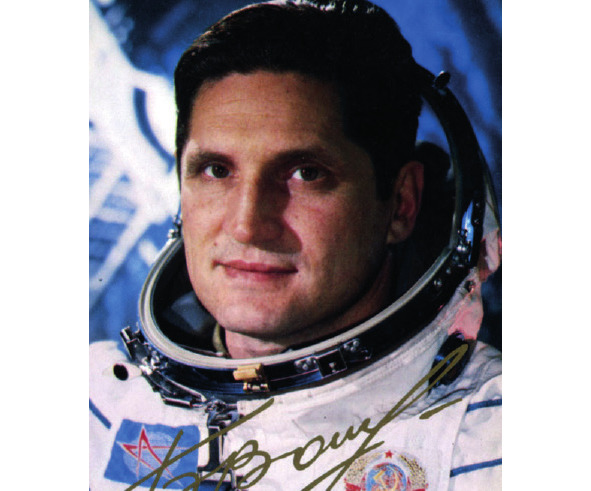
Cosmonaut B.V. Volynov
Irkutsk is a truly amazing place on the map of the globe. Let’s climb onto a small bridge, which rises 7 meters above the level of the roadway, which, by the way, equal to the height of the walls of the old Irkutsk wooden fortress, and look at the panorama that opens before us. At this point, the brown waters of Irkut River merge with the purest stream of the Angara. In a good weather, and especially in winter, you can see stones at the bottom of the river, despite the 6-meter depth. And the speed of the current is so fast that even in 40-degree frosts the river does not freeze. Although, until January 1952, the river was seized by ice, starting from this place, which caused frequent and serious winter floods. As a result of these cataclysms, the water went deep into the city sometimes up to 400 m, leaving behind an ice captivity. Today the Irkutsk hydroelectric power station has regulated the flow of Baikal waters and the Angara has stopped freezing and flooding.

